Physical Address
304 North Cardinal St.
Dorchester Center, MA 02124
Physical Address
304 North Cardinal St.
Dorchester Center, MA 02124
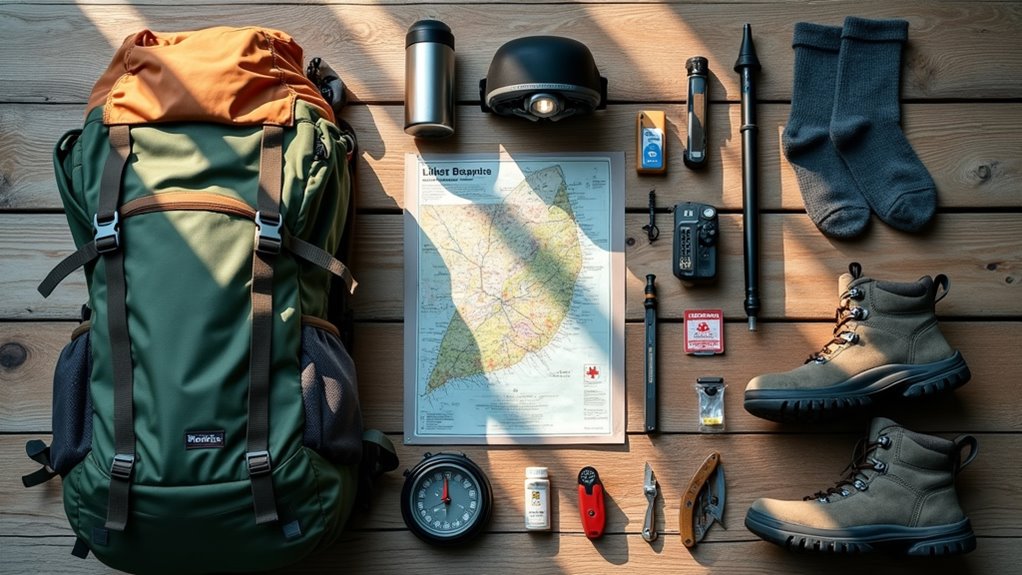
Hiking experts reveal their most essential gear picks - from life-saving tools to budget-friendly basics every trail adventurer needs.
Picture yourself standing at a misty trailhead, enthusiastic to explore but unsure if you’ve packed the right gear. You don’t need to spend a fortune on equipment to hike safely, but you can’t afford to skip the essentials either. Whether you’re planning a day hike or a weekend trek, knowing which pieces of gear truly matter will save you money and potentially save your life. Let’s examine the ten pieces of equipment that experienced hikers won’t leave home without.
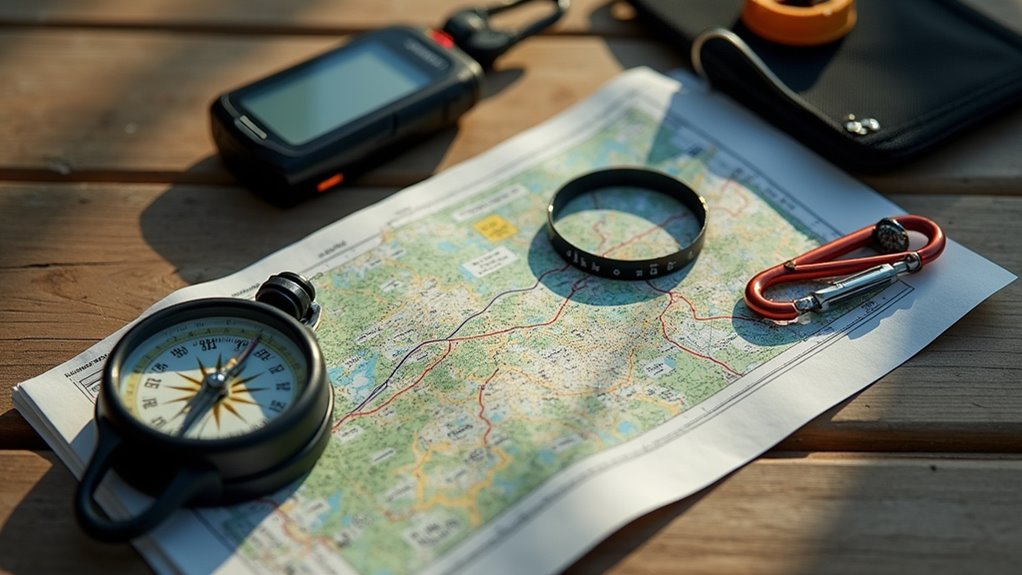
When venturing into the wilderness, having reliable navigation tools can mean the difference between an enjoyable hike and a dangerous situation.
Start with a basic magnetic compass and topographic map – they’re essential tools that don’t rely on batteries or signals. Taking time to practice map and compass skills in familiar local terrain will build crucial confidence before venturing further. If your budget allows, invest in a GPS device or watch with adjustable declination and breadcrumb tracking capabilities.
A compass and map are your lifeline in the wilderness – no batteries required, just pure navigational reliability.
For digital navigation, download apps like AllTrails+ or GaiaGPS, which offer offline access to topographic data. Remember to carry backup power for your electronic devices. Mastering navigation without a compass can be a valuable skill in case you find yourself without one.
An altimeter can help you pinpoint your location in steep terrain, while a whistle serves as a simple but effective emergency signal.
Don’t rely solely on your smartphone – combine multiple navigation tools to guarantee you’re prepared for any situation on the trail.
A properly layered clothing system serves as your first line of defense against unpredictable weather conditions on the trail.
Start with a moisture-wicking base layer made of merino wool or synthetic materials to keep your skin dry. Add a mid layer of fleece or synthetic insulation for warmth without bulk, which you can easily remove when you heat up. Down insulation jackets provide an excellent warmth-to-weight ratio for cold conditions.
Top it off with a breathable, weather-resistant outer shell to protect against wind and rain. You don’t need expensive brand names – focus on functionality and durability. Essential cold-weather gear is crucial for any outdoor adventure.
Look for UPF protection in your base layer and water-resistant properties in your shell. Test your layers before hitting challenging trails, and maintain them properly to extend their life.
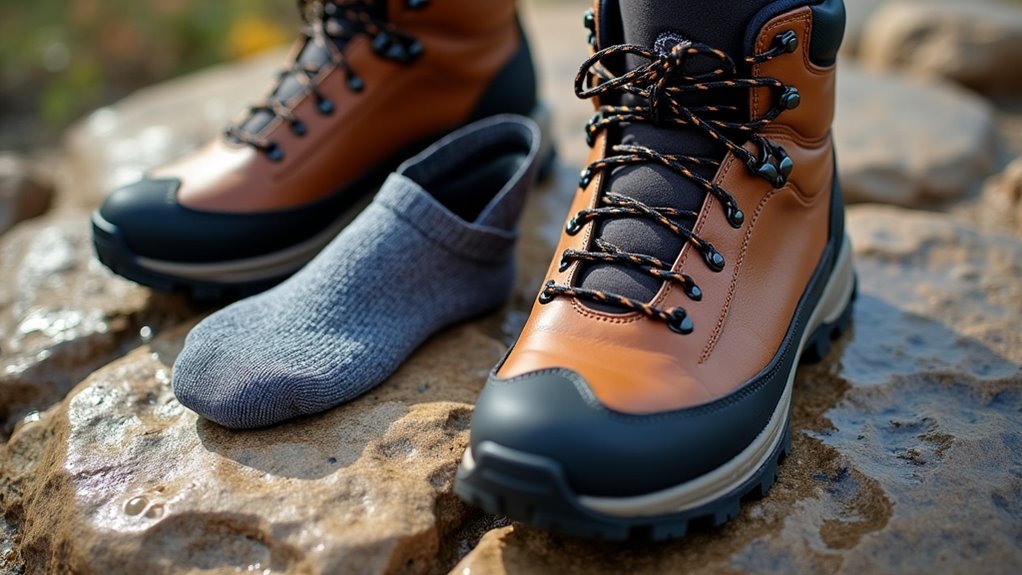
Your feet are the foundation of any successful hike, making proper footwear just as important as your layered clothing system. When choosing hiking shoes, focus on models that offer both waterproofing and breathability through technologies like Gore-Tex membranes and mesh panels.
Look for shoes with responsive cushioning systems, such as CloudTec or Helion superfoam, which provide stability and comfort across varying temperatures. The innovative Vibram outsole compound used in many hiking shoes delivers exceptional grip and traction on challenging terrain. Proper moisture control is essential for maintaining comfort and preventing blisters on long hikes.
Consider your typical hiking terrain when selecting footwear. If you’re tackling rugged trails, opt for shoes with aggressive tread patterns and enhanced ankle support. For urban trails, lighter options with good moisture-wicking properties will suffice.
Don’t forget to match your footwear to weather conditions – waterproof membranes for wet conditions, breathable materials for desert heat, and insulated options for snow and ice.
Proper hydration management serves as a cornerstone of safe hiking, requiring both reliable water carrying systems and effective treatment methods.
Maintaining proper hydration through reliable gear and water treatment isn’t just about comfort – it’s essential for hiking safety.
You should begin with a quality hydration pack like the Osprey Skarab 30 or Gregory Inertia 24 H2O, which offer both water storage and gear capacity. Most hikers find that packs with 2 to 2.5 liters of water capacity provide the ideal balance for day hikes.
For water treatment, you’ve got several cost-effective options. Water purification tablets provide a lightweight solution, while portable filters like LifeStraw offer immediate access to clean water. You can also use UV purifiers for thorough protection against contaminants. Essential water filters are crucial for extended camping adventures.
Don’t forget to maintain your hydration system. Clean your bladder regularly with a water-vinegar solution and use a drying rack to prevent bacterial growth.
Secure your hydration hose with the pack’s magnetic clips to prevent damage during your hike.
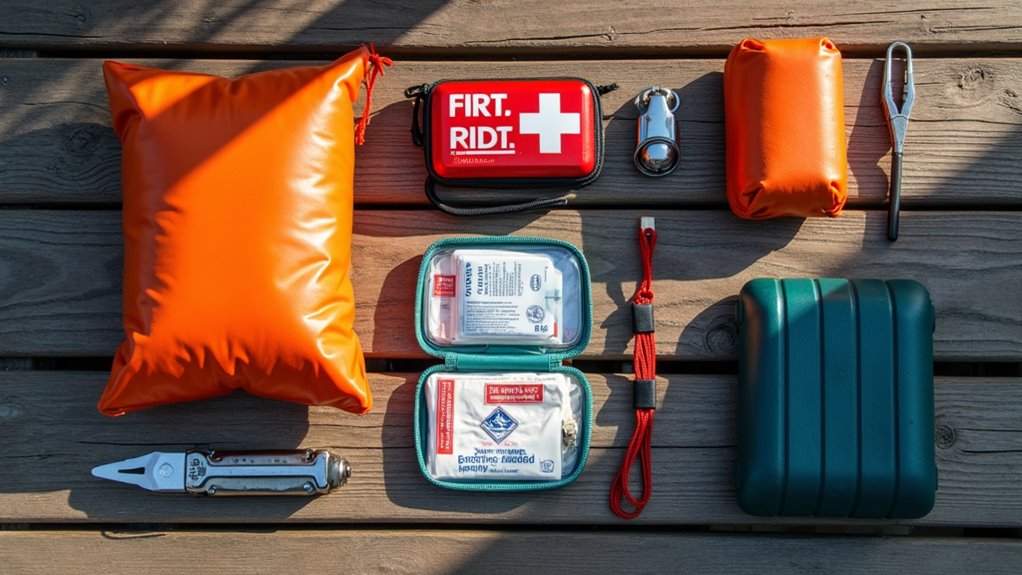
When venturing into the wilderness, reliable emergency shelter and first aid supplies can mean the difference between a minor setback and a serious crisis.
Pack an ultralight tarp or emergency space blanket for protection against wind and rain. Consider stocking your first aid kit with treatments for blisters. Don’t forget a basic first aid kit with pain relievers, bandages, and antibiotic ointment.
Your emergency gear should include essential tools like a multi-tool, whistle, and fire starters. Essential first aid kit tips can help ensure you’re prepared for unexpected situations.
Keep a few key safety items handy: personal ID, emergency contacts, and a detailed itinerary left with friends. If you’re hiking in bear country, carry bear spray for protection.
Before heading out, check the weather forecast and pack appropriate clothing layers.
Remember to include a compact first aid guide – you’ll want clear instructions if you need to treat injuries on the trail.
Every hiker needs reliable light sources and power banks for safety and navigation after dark. Pack a headlamp with red light mode for hands-free illumination and night vision preservation, plus an LED flashlight as backup.
Solar-powered lights can reduce your reliance on batteries during extended trips. Camping lanterns can also provide ample lighting for your campsite.
For power solutions, consider the Nitecore NB10000 Gen 3, a lightweight 10,000mAh power bank that’s both waterproof and dustproof. If you’re planning longer treks, opt for a 25,000mAh model with multiple ports. The ultralight device weighs just 5.3 ounces making it perfect for minimalist hikers.
Look for pass-through charging capability and quick-charge output to maximize efficiency. Don’t forget essential accessories like durable cables and protective cases.
Solar panel compatibility can extend your power bank’s utility, especially in remote areas where charging opportunities are limited.
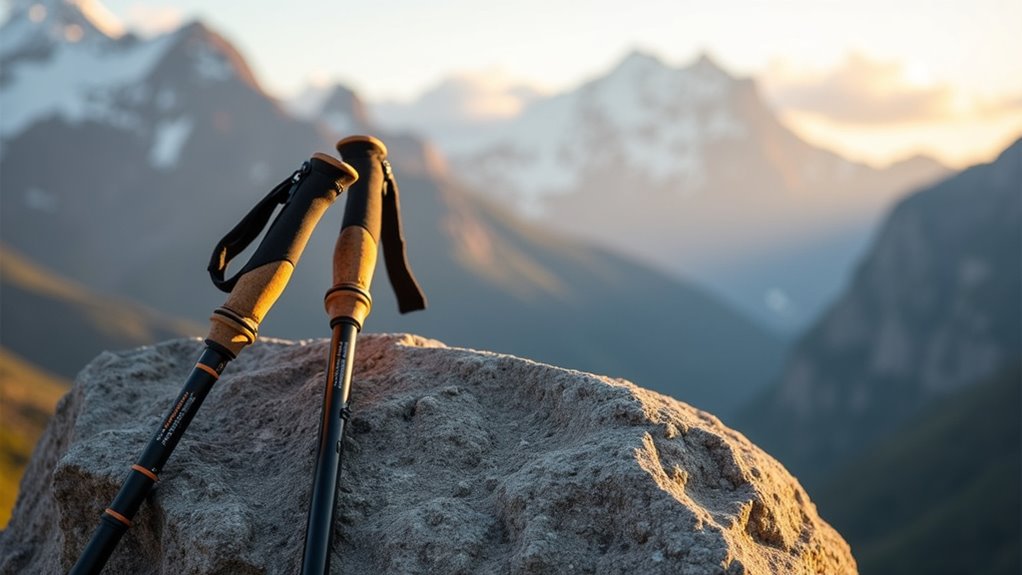
Selecting terrain-appropriate trekking poles can dramatically improve your hiking stability and reduce joint strain.
For rugged terrain, you’ll want aluminum poles with sturdy locking mechanisms and durable tips. They’re heavier but more reliable on challenging paths. The Black Diamond Pursuit exemplifies this durability with its top construction quality rating of 10.0.
If you’re focused on ultralight backpacking, carbon fiber poles like the Gossamer Gear LT5 offer excellent weight savings without compromising strength. Essential gear for your next hiking adventure should include lightweight equipment to maximize your comfort and endurance.
For winter hikes, make sure your poles include snow baskets and ice picks for added stability.
Consider your grip preference – cork handles work best for sweaty hands and long distances, while foam grips offer better cold-weather performance.
You don’t need to spend a fortune; brands like REI Flash Carbon provide great value with balanced features.
When choosing, prioritize your most common terrain type and hiking style over fancy additional features.
Protecting yourself from harsh elements and UV exposure should be a top priority for any hiker. You’ll need UPF-rated clothing with ratings of 50+ that blocks 98% of UV rays. Opt for moisture-wicking materials like merino or synthetics, and choose between form-fitting or relaxed styles based on your comfort. Look for shirts with integrated thumbholes to keep sleeves in place and protect your hands while hiking.
Smart hikers prioritize UV protection with UPF 50+ clothing and moisture-wicking materials to stay safe and comfortable on the trail.
Don’t forget essential accessories like wrap-around sunglasses, a sun hat, and a versatile buff for neck protection. Apply broad-spectrum SPF 30 sunscreen and reapply frequently, especially at high altitudes. Wearing a wide-brimmed hat can also help protect your face and neck from the sun’s harmful rays.
Pack waterproof jackets and insulating layers for weather changes, and bring bug-repellent gear for areas with dense vegetation. You’ll also want emergency items like a first aid kit and communication devices.
Most importantly, stay hydrated by carrying sufficient water and electrolytes, along with energy-rich snacks.
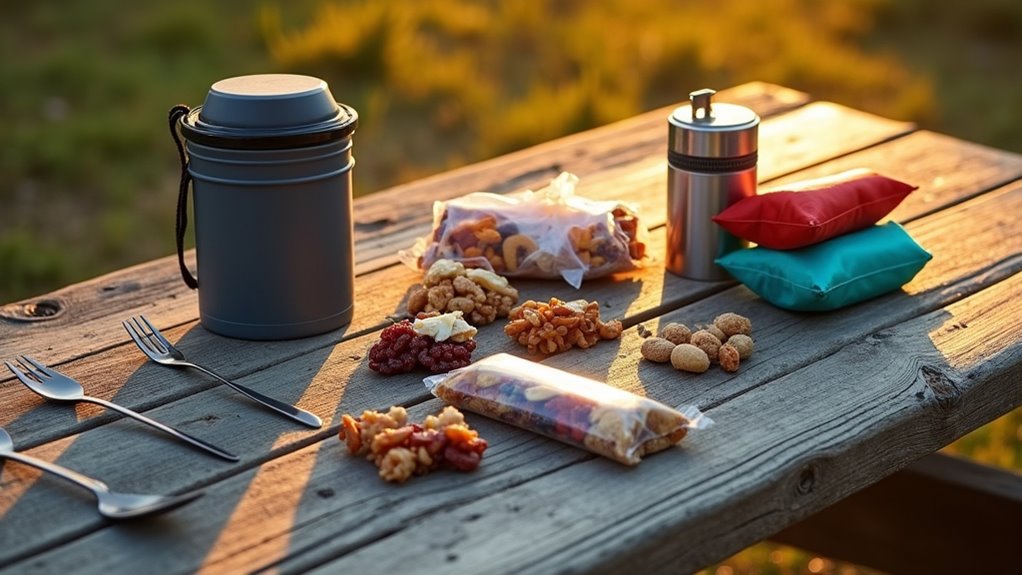
Proper nutrition can make or break your hiking experience, demanding careful attention to both what you eat and how you store it.
You’ll need 3,000-4,000 calories daily, with 45-55% coming from carbohydrates to maintain energy. Pack about 1.5-2 pounds of food per day, focusing on lightweight, calorie-dense options. Electrolyte drinks help maintain proper hydration and mineral balance during strenuous hikes.
Consume 30-60 grams of carbs hourly through energy gels, dried fruits, or sports drinks. Include foods abundant in omega-3s to combat inflammation. Delicious no-cook recipes can be a great option for your camping adventure.
Start with fresh foods and shift to preserved options as your hike progresses. You’ll save money and space by portioning meals into resealable bags.
Don’t forget proper storage – use bear-proof containers where needed and keep food in airtight bags to prevent spoilage and unwanted wildlife encounters.
Regular inspection of your supplies guarantees food safety throughout your journey.
Three essential items form the foundation of any hiking repair kit: a reliable multi-tool, duct tape, and paracord. Finding the right camping knife is also an important consideration when assembling your gear.
Your multi-tool should include a knife blade, pliers, scissors, and saw – all vital for emergency repairs on the trail. The durable Leatherman Wave+ offers all these functions in one reliable tool. Duct tape can patch tent holes, seal leaks, and fix torn backpacks, while paracord serves countless purposes from securing gear to creating makeshift repairs.
Don’t forget to pack adhesive patches and a basic sewing kit with needles and thread.
Add a few safety pins, zip ties, and webbing straps – they’re lightweight solutions for broken buckles and torn straps.
Keep your repair kit compact and accessible in a waterproof container. You’ll want these tools readily available when gear fails miles from civilization.
You’ll find that investing in quality hiking gear pays off, considering that 77% of hiking accidents are preventable with proper equipment and preparation. Don’t feel pressured to buy everything at once – start with essential safety items and gradually build your collection. By prioritizing multi-functional gear and shopping during seasonal sales, you can assemble a reliable hiking kit without breaking the bank.